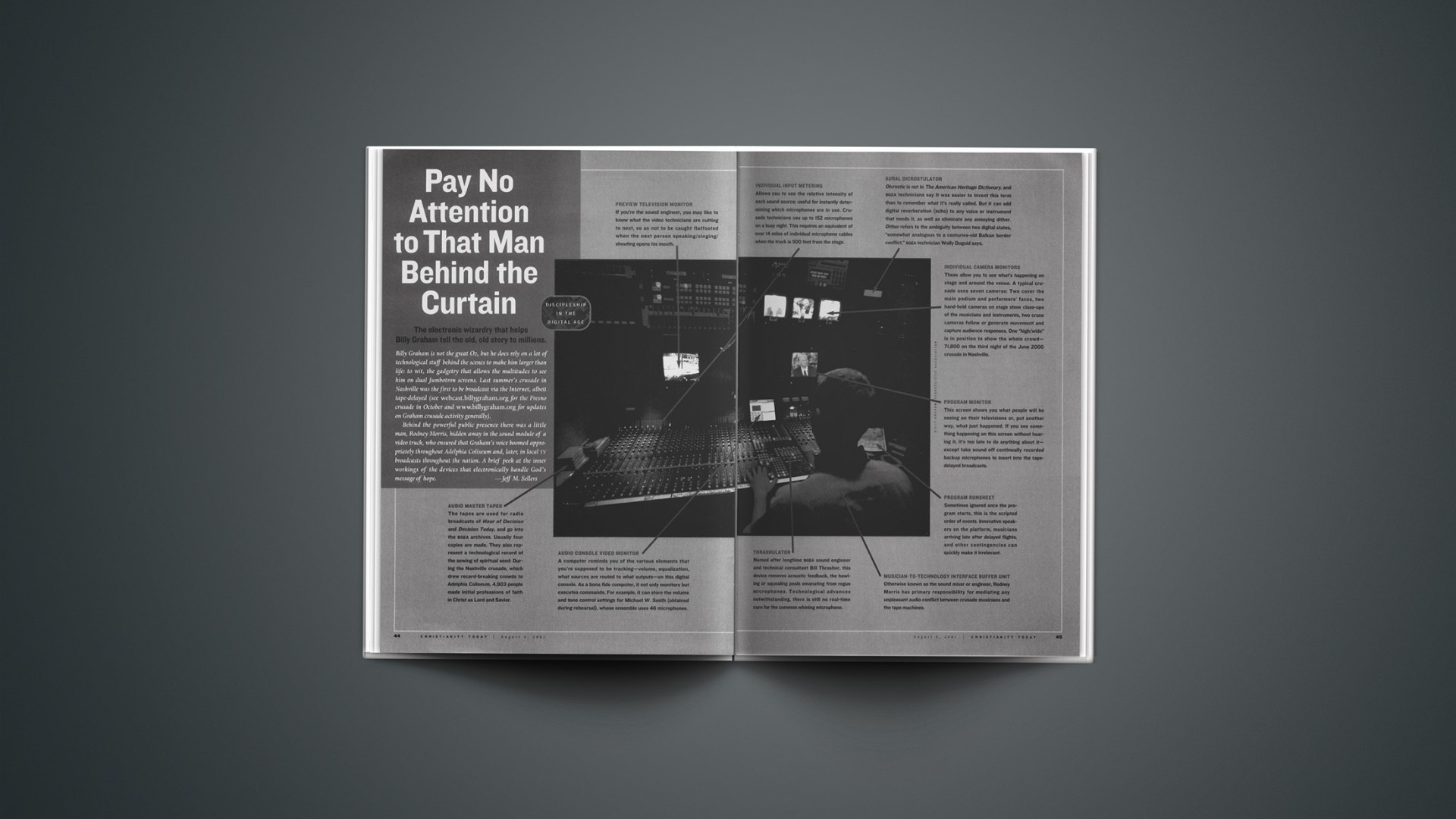Billy Graham is not the great Oz, but he does rely on a lot of technological stuff behind the scenes to make him larger than life: to wit, the gadgetry that allows the multitudes to see him on dual Jumbotron screens. Last summer’s crusade in Nashville was the first to be broadcast via the Internet, albeit tape-delayed (see webcast.billygraham.org for the Fresno crusade in October and www.billygraham.org for updates on Graham crusade activity generally).
Behind the powerful public presence there was a little man, Rodney Morris, hidden away in the sound module of a video truck, who ensured that Graham’s voice boomed appropriately throughout Adelphia Coliseum and, later, in local tv broadcasts throughout the nation. A brief peek at the inner workings of the devices that electronically handle God’s message of hope.
Audio Master Tapes
The tapes are used for radio broadcasts of Hour of Decision and Decision Today, and go into the BGEA archives. Usually four copies are made. They also represent a technological record of the sowing of spiritual seed: During the Nashville crusade, which drew record-breaking crowds to Adelphia Coliseum, 4,903 people made initial professions of faith in Christ as Lord and Savior.
Preview Television Monitor
If you’re the sound engineer, you may like to know what the video technicians are cutting to next, so as not to be caught flatfooted when the next person speaking/singing/ shouting opens his mouth.
Audio Console Video Monitor
A computer reminds you of the various elements that you’re supposed to be tracking—volume, equalization, what sources are routed to what outputs—on this digital console. As a bona fide computer, it not only monitors but executes commands. For example, it can store the volume and tone control settings for Michael W. Smith (obtained during rehearsal), whose ensemble uses 46 microphones.
Individual Input Metering
Allows you to see the relative intensity of each sound source; useful for instantly determining which microphones are in use. Crusade technicians use up to 152 microphones on a busy night. This requires an equivalent of over 14 miles of individual microphone cables when the truck is 500 feet from the stage.
Aural Dicrostulator
Dicrostic is not in The American Heritage Dictionary, and BGEA technicians say it was easier to invent this term than to remember what it’s really called. But it can add digital reverberation (echo) to any voice or instrument that needs it, as well as eliminate any annoying dither. Dither refers to the ambiguity between two digital states, “somewhat analogous to a centuries-old Balkan border conflict,” BGEA technician Wally Duguid says.
Individual Camera Monitors
These allow you to see what’s happening on stage and around the venue. A typical crusade uses seven cameras: Two cover the main podium and performers’ faces, two hand-held cameras on stage show close-ups of the musicians and instruments, two crane cameras follow or generate movement and capture audience responses. One “high/wide” is in position to show the whole crowd—71,800 on the third night of the June 2000 crusade in Nashville.
Program Monitor
This screen shows you what people will be seeing on their televisions or, put another way, what just happened. If you see something happening on this screen without hearing it, it’s too late to do anything about it—except take sound off continually recorded backup microphones to insert into the tape-delayed broadcasts.
Program Runsheet
Sometimes ignored once the program starts, this is the scripted order of events. Innovative speakers on the platform, musicians arriving late after delayed flights, and other contingencies can quickly make it irrelevant.
Musician-to-Technology Interface Buffer Unit
Otherwise known as the sound mixer or engineer, Rodney Morris has primary responsibility for mediating any unpleasant audio conflict between crusade musicians and the tape machines.
Thrashulator
Named after longtime BGEA sound engineer and technical consultant Bill Thrasher, this device removes acoustic feedback, the howling or squealing peals emanating from rogue microphones. Technological advances notwithstanding, there is still no real-time cure for the common whining microphone.
Copyright © 2001 Christianity Today. Click for reprint information.










